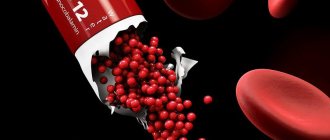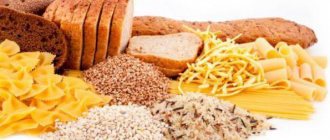What is acidification and alkalization of the body?
Alkalinization of the body involves following special diets that restore the acid-base balance. Let's take a short digression to properly understand what kind of balance this is. All chemical reactions occur in the body taking into account the concentration of hydrogen ions (H+). The pH level is an indicator of the hydrogen content in liquids:
- with an increase in H+ in the blood, the pH decreases;
- with a decrease in H+ in the blood, pH increases.
In order for cells to cope with their work, the content of hydrogen ions must be within the established norm. A high concentration of hydrogen acidifies the blood and leads to acidosis. Low concentrations alkalize the blood, resulting in alkalosis. In the first case, alkalization is required to improve human health. In the second - acidification.
Reference!
The pH level ranges from 1 (acidic) to 14 (alkaline). For the body, a pH value in the range of 7.35-7.45 is considered normal. However, pH varies greatly. The most “acidic” organ is the stomach. The high acid content helps it digest food.
Acidification and alkalization of the body: is it important?
The acidity of liquids and biological media is usually measured in pH. We often hear about the dangers of over-acidification of the body and the importance of alkalizing with healthy foods. There are even recommendations about the possible benefits of baking soda for this. But what exactly is pH and what does its level mean?
Everything is explained quite simply: translated from Latin, pH means pondus hydrogenii - “weight of hydrogen”. That is, when we talk about the pH value, we mean the concentration of hydrogen ions in the liquid or medium under study.
In this case, we are of course interested in the pH level of our internal environment of the body.
Hydrogen ion (H+) is one of the most active chemical substances, the concentration of which can significantly change the rate of chemical reactions, having a significant impact on many vital processes in the body:
- physicochemical state of cell membranes;
- the ability of hemoglobin to bind oxygen;
- sensitivity of receptors to biologically active substances;
- excitability and conductivity of nerve structures;
- enzyme activity and many other processes.
Pressure in blood vessels, headaches, metabolic disorders and gastrointestinal problems, irritability, weakness and drowsiness are often a consequence of pH imbalance in the body.
What is pH
◯ A liquid with a pH level of 7 is considered neutral, such as pure water. ◪ Liquids with a pH level below 7, such as lemon juice or coffee, are considered acidic. ◪ Liquids with a pH level above 7, like human blood, are considered alkaline.
What makes a liquid a neutral substance is an equal amount of hydrogen ions and hydroxyl ions (OH-).
If the concentration of H+ increases, the concentration of OH- decreases accordingly, then the medium becomes acidic. The more hydrogen ions it contains, the more pronounced the acidic reaction.
Conversely, if the H+ concentration decreases, the OH- concentration increases. Then the solution turns into an alkali - the more hydroxyl ions, the more pronounced the alkaline reaction.
pH is denoted as the inverse decimal logarithm. Thus, in the pH level, each value is ten times different from the next number. Thus, a medium or solution with a pH level of 6 is ten times more acidic than a liquid with a pH level of 7, and a liquid with a pH level of 5 is one hundred times more acidic than pure water.
Highly carbonated drinks have a pH level of about 3, their acidity is a thousand times higher than that of pure water.
Is it true that the food and drinks we consume determine whether our blood is alkaline or acidic?
This is not entirely true as it turns out! And that's why:
The fact is that the body independently regulates the normal pH level of the internal environment to maintain a level slightly more alkaline than pure water (from 7.35 to 7.45). Therefore, the food we eat does not cause significant fluctuations in pH levels.
Where then do the rumors about the need to alkalize the body come from?
When eating food or liquid, the end products of metabolism (the breakdown and absorption of nutrients) contain a so-called acidic or alkaline precipitate. In addition, in the fluids of the internal environment of the body itself, a certain amount of various acids that naturally arise in everyday metabolism is constantly formed and broken down.
Thus, there are two factors that influence the body’s pH level: exogenous (acidic or alkaline effects of food and drinks) and endogenous (acids formed by the body itself during metabolic processes).
If the blood pH level drops below 7.35, a condition called acidosis occurs. When the blood pH level exceeds 7.45, alkalosis occurs. Like acidosis, acute alkalosis could also be fatal, but this does not happen when we drink a lot of acidic foods or, conversely, consume a lot of alkaline foods.
Fortunately, the body has three mechanisms that constantly work to maintain normal blood pH.
Blood buffer systems (carbonate, phosphate, protein, hemoglobin)
This mechanism acts very quickly (fractions of a second) and therefore belongs to the fast mechanisms for regulating the stability of the internal environment.
The bicarbonate blood buffer is the most mobile ; it is an open buffer system. The main function of the bicarbonate buffer system of the blood is the neutralization of H+ ions. This buffer system plays a particularly important role.
The hemoglobin buffer system is the most powerful . It accounts for more than half of the buffer capacity of the blood. The buffering properties of hemoglobin are determined by the ratio of reduced hemoglobin and its potassium salt.
Plasma proteins , due to the ability of amino acids to ionize, also perform a buffer function (about 7% of the buffer capacity of the blood). In an acidic environment they behave as acid-binding bases.
The phosphate buffer system (about 5% of the buffer capacity of the blood) is formed by inorganic phosphates in the blood. The properties of an acid are exhibited by monobasic phosphate (NaH2P04), and the properties of bases are exhibited by dibasic phosphate (Na2HP04). They function on the same principle as bicarbonates. However, due to the low content of phosphates in the blood, the capacity of this system is small.
Respiratory (pulmonary) regulation system
Because of the ease with which the lungs regulate CO2 concentrations, this system has significant buffering capacity. Removal of excess amounts of CO2 and regeneration of bicarbonate and hemoglobin buffer systems are carried out by the lungs.
At rest, a person emits 230 ml of carbon dioxide per minute. When carbon dioxide is removed from the blood, approximately an equivalent amount of hydrogen ions disappears. Therefore, if the acidity of the blood increases, then the increase in the content of hydrogen ions leads to an increase in pulmonary ventilation (hyperventilation), while carbon dioxide molecules are excreted in large quantities and the pH returns to normal levels.
The respiratory system is able to quickly (within a few minutes) eliminate or reduce the pH shift and prevent the development of acidosis or alkalosis: increasing pulmonary ventilation by 2 times increases the blood pH by about 0.2; reducing ventilation by 25% can reduce pH by 0.3-0.4.3.
Renal (excretory system)
Acts very slowly (10-12 hours). But this mechanism is the most powerful and is capable of completely restoring the body’s pH.
The participation of the kidneys in maintaining acid-base balance is the removal of hydrogen ions from the body, reabsorption and synthesis of bicarbonate from the tubular fluid when there is a deficiency and removal when there is excess. The kidneys are able to bind hydrogen ions with ammonia, which maintains the pH of the blood. When there is an excess of hydrogen ions, the renal tubular epithelium releases H+ into the lumen of the tubule in the form of either undissociated acid or [NH4+].
At the same time, the formation of ammonia from amino acids, including glutamic acid, increases in the tubular epithelium. Ammonia is secreted into the lumen of the tubule, where it binds hydrogen ions and turns into ammonium, which is not reabsorbed and is therefore excreted in the urine.
The mechanism for regulating blood pH in the whole organism is the combined action of external respiration, blood circulation, excretion and buffer systems.
Thus, if excess anions appear as a result of increased formation of H2CO3 or other acids, they are first neutralized by buffer systems. At the same time, breathing and blood circulation intensify, which leads to an increase in the release of carbon dioxide by the lungs. Non-volatile acids, in turn, are excreted in urine or sweat.
When you are told to “alkalize your blood,” what they basically mean is that you should eat more food that will form alkaline in your body. The reason for this suggestion is that most grocery products, such as flour products and foods with a lot of refined sugar (such as cookies and candy), are acidic.
As a result, some of the buffer systems mentioned above begin to work under increased load, which is accompanied by an increased consumption of nutrients necessary for their functioning.
For example, the phosphate buffer system uses the body's various phosphate ions to neutralize concentrated acids and nucleotides. About 85% of the phosphate ions used by this buffer system are derived from calcium phosphate salts, which are structural components of bones and teeth.
If the body is chronically exposed to large amounts of acid-producing food and liquid, it will use calcium phosphate storage to provide a phosphate buffer system to counteract the effects of the diet. Over time, this can lead to structural deterioration of bones and teeth.
Since buffer systems in any case must neutralize the acids formed as a result of everyday metabolic processes, it is logical to adhere to a diet that would not force the buffer system to become uselessly depleted. Theoretically, you should consume more alkaline-forming foods than acid-forming foods for the overall acid-base effect of the diet to correspond to a slightly alkaline blood pH level.
The following list shows which simple foods have an alkali-forming effect on body fluids, and which ones affect the formation of acid waste during digestion and assimilation.
To complete the understanding, we can consider the chemical effect of these products on the acid-base balance of the internal environment of the body, or more precisely, the derivatives of these products that are absorbed into the internal environment of the body after the food eaten has gone through a full digestion cycle.
In the case of animal proteins, these are amino acids; in the case of plant proteins, these are also amino acids, but with a lower molecular weight; in the case of most products of plant origin, these are sugars, fruit organic acids and salts of these formed in the digestive tract from organic acids acids
In both cases, the flow of substances absorbed into the internal environment, in addition to proteins, sugars, organic acids and their salts, also contains fats, water and minerals, including trace elements and vitamins. But the main distinctive feature of the effect on the acid-base balance of blood, lymph and interstitial fluid in the first case is the presence of amino acids, and in the second - organic acids and their soluble salts.
Let us consider the mechanism of the influence of organic acids and their salts on the shift of the acid-base balance to the alkaline side.
Why do organic acids, which by their chemical nature have acidic properties, do not acidify, but rather (!) alkalize the internal environment of the body.
The solution to this paradox becomes obvious when we take into account that it is not the organic acids themselves that enter the internal environment of the body from the intestine, but the salts of these acids.
And the school chemistry course knows that soluble organic salts are salts formed by weak acids and strong bases, alkali and alkaline earth metals of groups I and II of the Mendeleev periodic system, with pronounced alkali-forming properties.
In this case, salts formed by a strong base and a weak acid are hydrolyzed in an aqueous environment to form a weak acid and a strong base (alkali), while the alkali dissociates, and the weak acid is destroyed with the release of carbon dioxide and water.
Thus, a short time after the salts of organic acids have passed into the internal environment of our body, alkalis, carbon dioxide and water remain from them.
The direction of metabolic processes in the human body is such that carbon dioxide formed during the metabolic process is constantly removed from our body through the lungs.
Thus, carbon dioxide formed as a result of the hydrolysis of salts of organic acids will be removed, as will the water formed during the hydrolysis process.
What will remain in the internal environment? An alkali will remain, which, in accordance with its chemical nature, will shift the acid-base balance of the blood, lymph and interstitial fluid to the alkaline side.
Why does the internal environment of the body become acidic due to the consumption of meat and meat products?
I believe that answering this question will not be so difficult if we look at the chemical structure of the protein molecule. Animal protein macromolecules include, in addition to carbon and hydrogen atoms, also atoms of acid-forming elements such as sulfur, nitrogen and phosphorus.
Why are these acid-forming elements? Because the oxides of these elements, when dissolved in water, produce acids. This is a timely remark, because in the process of metabolism, protein molecules undergo a successive series of redox reactions, the result of which is carbon dioxide, water and oxides of acid-forming elements. Dissolving in water, which makes up more than 95% of the human internal environment, they form the very acids that shift the acid-base balance of blood, lymph and interstitial fluid to the acidic side.
How can you help the body maintain acid-base balance in balance?
If you stick to a reasonable diet, don’t overeat and eat enough fresh herbs, vegetables and fruits, then the buffer systems won’t have to constantly work to bring the pH into balance.
And here it becomes difficult to overestimate the benefits of physical education and sports, because it is enough to exercise or work intensively for 40-50 minutes in the fresh air and the acid-base balance shifts to the alkaline side, due to the intense influx of oxygen into the body and the washing out of excess carbon dioxide from the blood ( pulmonary pH regulation system).
The following literature was used in preparing the article:
Paukov V.S., Litvitsky P.F. Pathology: Textbook. – M.: Medicine, 2004. – 400 p. ISBN 5-225-04860-9
Malyshev V.D. Acid-base state and water-electrolyte balance in intensive care: Textbook. – M.: Medicine, 2005. – 228 p. ISBN 5-225-04698-3
Agadzhanyan N.A., Tel L.Z., Tsirkin V.I., Chesnokova S.A. Human physiology. – M.: Medical Book, 2009. ISBN 978-5-86093-061-2
Lazebnik L. B. Aging: a professional medical approach/L. B. Lazebnik, AL. Vertkin, Yu.V. Konev, E.D. Lee, A.S. Skotnikov. - M.: Eksmo, 2014. - 320 p. – (National leadership). ISBN 978-5-699-68589-9
Did you like the article? Share with your friends, maybe they will find it useful:
Read: 576
#Alkalization#Healthy lifestyle#Healthy eating
Posted By
Boris Anufriev
Nutritionist, healthy lifestyle consultant, leading methodologist at the Academy of Vision.
You might also like
392
Secrets of a healthy lifestyle
Adequate sleep as the foundation of quality of life
11/11/2019
151
Secrets of a healthy lifestyle
Biorhythms: everyone has their own or is it self-deception?
08.11.2019
158
Secrets of a healthy lifestyle
Biohacking as a professional approach to exploiting the body
11/06/2019
More from Healthy Lifestyle Secrets
499
Hardening of children of preschool and primary school age
Published 03/17/2020 Boris Anufriev 0
It has been proven that systematic hardening reduces children’s susceptibility to colds and has a positive effect on the child’s behavior.
75
Is hardening so scary and is it necessarily associated with ice water?
Published 03/17/2020 Boris Anufriev 0
There are more and more reasons to maintain a healthy level of immunity, and all kinds of vitamins and dietary supplements do not provide a noticeable increase in work efficiency...
234
Qigong and auto-training: what it is and how it works
Published 10/11/2019 Fyodor Simonov 0
The tissues of our body are constantly renewed, this is inherent from birth. But why then does aging occur? For what reasons, different people...
How to determine acidification of the body: symptoms
Violation of the acid-base balance leads to disruptions that affect a person’s well-being. Acidification of the body has a number of characteristic manifestations:
- destruction of tooth enamel;
- damage to the hair structure;
- dry skin syndrome;
- joint inflammation;
- cramps after physical activity;
- regular headache;
- overweight;
- pressure fluctuations;
- diabetes (type 1 and 2);
- heart attacks and strokes.
Deviation of the pH value from the norm poses a health hazard. Products that acidify the body destroy it from the inside. Ignoring the maintenance of normal acid-base balance often becomes the basis for the development of oncology. Normally, the body self-regulates the pH level in the blood. An imbalance occurs at the initiative of a person. The following factors provoke it::
- improper diet;
- lack of physical activity;
- bad habits (drinking alcohol, smoking).
Dangerous consequences for the body do not appear immediately. Therefore, people who eat poorly and lead a sedentary lifestyle are advised to know their pH levels before painful symptoms occur.
Medicine has identified a list of foods that acidify the body:
- sugar and sweets;
- chocolate;
- tea (green, black);
- coffee;
- alcohol;
- milk, cheese, cottage cheese and other dairy products;
- yeast baked goods;
- food with preservatives;
- cereal porridges (including brown rice);
- carbonated and sweet drinks;
- dried fruits;
- red meat (to a lesser extent – chicken meat).
Acidifying foods destroy health gradually, since the harm from their consumption is cumulative. There are other causes of acidification in the body. These include irregular sleep, constant stress, and lack of physical activity. In this regard, both physical and psychological therapies are recommended to alkalize the body.
Recipes and methods at home
Most public clinics do not perform the procedure for alkalizing the body; only some private entrepreneurs can provide it. However, you can resort to a procedure such as alkalizing the body with soda at home.
Application of soda according to Neumyvakin
Dr. Neumyvakin claims that thanks to soda you can rejuvenate the human body. His method is based on the fact that the acid-base balance should always be at one, strictly defined level, and if the indicator begins to deviate significantly from normal, the development of serious diseases may begin.
According to his theory, soda should be used as follows:
- You should take soda three times a day, an hour before breakfast, lunch and dinner.
- Treatment should begin with small dosages - from a quarter to half a teaspoon of soda per glass of water. Do not take large doses under any circumstances, otherwise severe gastrointestinal upset may occur, which will interfere with the normal absorption of the substance by the body.
- Soda should not be stirred. It is enough to pour the required amount of powder into the bottom of the glass, then fill it with warm water. If the soda refuses to dissolve, pour boiling water over it, then let the solution cool naturally.
- If you use milk instead of water, the healing effect of soda will increase.
Interesting video: Neumyvakin Acid-base balance
The use of soda according to Ogulov
Dr. Ogulov offers his own soda treatment method. His method is recognized as one of the most popular ways to alkalize the body with soda at home.
There are a huge number of positive reviews about his five famous recipes:
- To alkalize the body with soda, dissolve half a teaspoon of soda in a glass of hot water, then let the solution cool slightly and drink in one gulp. It is better not to stir the solution and wait for the natural completion of the diffusion process. The course of treatment ranges from seven to fourteen days, one dose per day.
- To thin the blood, add a third of a teaspoon of soda to half a glass of warm water. Stir the solution thoroughly and drink. Continue treatment for one or two weeks, then take a ten-day break and repeat the course. Then, after a second ten-day break, preventive treatment can be continued for life, taking the solution once a week.
- Baking soda enema recipe. Boil, then cool four-fifths of a liter of water to forty degrees and dissolve a heaped tablespoon of soda in it. Give the enema for twenty minutes, then go to the toilet. The procedure should be repeated every two days, treatment should be continued for two weeks. Then, after a seven-day break, repeat the course.
- To remove toxic substances through the pores of the skin, add eight tablespoons of soda to a bath of hot water. Bring the water temperature to a comfortable temperature. However, you should not lower it below forty degrees. Take a bath for an hour, add hot water if necessary. Repeat the treatment for ten days in a row. After a month, repeat the procedure. It is not recommended to resort to such a procedure during pregnancy or lactation, as well as high blood pressure or temperature, a number of diseases of the cardiovascular system, gynecological diseases and purulent skin lesions.
- If pigment spots associated with a fungus appear on the skin, they can be rubbed with dry baking soda powder. This method works great for them.
Interesting video: Soda thins the blood, treats cancer - Ogulov A.T.
The use of soda according to Bolotov
Dr. Bolotov also developed his own method of healing and rejuvenating the body. He claims that the effect of alkalization will increase significantly if you first acidify the body to the limit. This is necessary so that waste products, which are deposited in most tissues, are converted into salts under the influence of an acidic environment. Next, the body becomes alkalized, and they are eliminated. Unfortunately, this method is not suitable for everyone. If you experience headache, nausea or dizziness after taking baking soda, you should immediately stop using this method.
Bolotov points out two ways to take soda:
- As part of acid-base therapy. Over the course of a short course, the acidified body is alkalized with a glass of hot water in which half a teaspoon of soda is dissolved. It should be taken three times a day, half an hour before meals or an hour after.
- Lifetime use. Stabilizes the acid-base balance throughout a person’s life. To do this, it is enough to take a solution of a quarter to half a teaspoon in a glass of water once a week.
In order to effectively use acid-base therapy, you should know which foods promote acidification and which alkalize the body, and to what extent. To do this, you can use special tables or simply look at the list of products.
Green bananas, plum compote or jam, dried beans, dry peas, rice, buckwheat, starch, corn flakes, flour products, cheese, cream, sunflower oil, lamb, bacon, beef, chicken, honey, molasses, highly carbonated have a mild acidifying effect water and some others. Acidification is observed to a greater extent when consuming grape, orange or lemon juice, baked beans, walnuts, peanuts, chicken eggs (especially whites), liver, seafood, cocoa, chocolate and sweet carbonated drinks.
The opposite effect - alkalization - can be achieved by consuming most fruits, vegetables and berries, dried fruits and root vegetables, as well as amaranth, wild rice, oatmeal, millet, dairy and fermented milk products, lard, tea, lemon water, soda and natural apple cider vinegar .
It is better to start the acidification process with “coarser” products. Then gradually bring the acid-base balance to a critical level using low-acid products, and then alkalize with soda.
Interesting video: Boris BOLOTOV. Interview.
During treatment according to Bolotov, it is best to regularly check the acid-base balance so as not to exceed safe levels. Constant monitoring by a doctor is advisable. If your condition begins to worsen at any stage of treatment, the procedures should be stopped and the diet should be changed to the patient’s usual one. You should not try to compensate for the result of acidification of the body by alkalization and vice versa, since serious diseases can develop as a result. It is unknown how a particular organism will react to changes in food composition. There may simply be disturbances in the functioning of the gastrointestinal tract, in some cases a slight increase in temperature or surges in blood pressure. However, in more severe cases, diseases such as stomach and duodenal ulcers, liver dysfunction, and even previously hidden cancer may develop.
Acid-base balance tests
To find out your pH level, there is no need to go to clinics and undergo expensive examinations. Measurements are taken at home. All you need is a litmus indicator with a scale of five to nine points. You can purchase a set of such indicators at a pharmacy chain or a specialized medical store. The device operates with errors, but is suitable for home use.
To get results you will need two fluids - urine and saliva. A urine test is performed two hours before a meal or five hours after. Place saliva and urine in two different containers and immerse litmus indicator in them. Determining the acidity level takes from 15 to 30 seconds.
For reliable information, measurements should be taken within 7-10 days. The analysis takes into account the time of day. In the first half of the day, the acid-base balance is reduced. After lunch, the pH level rises. Slight fluctuations in values are considered normal.
Reference!
A blood test, which is carried out in a medical setting, will help summarize the research. It provides complete information about the state of immunological and digestive processes.
Benefits of alkalizing the body
Alkalinization of the body affects a number of vital body systems. These include:
- digestive: cleansing the intestines and normalizing metabolic processes. Removal of waste and toxins, weight control;
- immune: immunity is strengthened due to rapid cell division. Renewal at the cellular level helps accelerate tissue regeneration;
- enzymatic: the activity of enzymes, which are responsible for energy processes and a surge of strength, increases;
- bone: bone tissue is saturated with calcium, which helps strengthen it at any age.
Alkalinization of the body has a complex effect on the human body. According to a number of medical studies, an alkalizing diet blocks the development of malignant tumors.
Consequences of acidification of the body
Experts have long proven the relationship between many diseases and acidosis of the body. Back in 1932, biochemist Otto Warburg from Germany proved that an acidic environment in the body directly contributes to the occurrence and development of cancer. For this discovery he received the Nobel Prize at one time.
Fungi that cause cancer and most pathogenic bacteria die in alkaline conditions, even without the use of any medications. But malignant formations are not the only consequence of acidification of the body.
Firstly, the connective tissue suffers greatly. And these are intervertebral hernias, arthritis and arthrosis, osteoporosis. Secondly, the amount of slagging in the body increases significantly. This manifests itself not only at the level of the gastrointestinal tract, but also at the cellular level.
In addition, acidification leads to heart attacks, prostate problems, muscle weakness, fatigue and faster aging of the body. Also, such a phenomenon as subfibrile temperature is often associated precisely with the increased acidity of the internal environments of the body.
Effect on hemoglobin
The acid-base balance is responsible for the condition of the circulatory system. A decrease in pH levels leads to an increase in hemoglobin levels - and vice versa. When the body prevents acidification, it prevents the movement of water. Fluid retention leads to the following consequences:
- cells transport O2 to organs at a slower rate, useful minerals are washed out of the body;
- Ca, Mg and Fe are excreted, which leads to a rapid drop in hemoglobin levels;
- the remaining iron is used to reduce acidity levels and is not consumed for its intended purpose.
A drop in hemoglobin is accompanied by the following symptoms:
- chronic fatigue and sleep disturbances;
- increased irritability;
- disturbance of mental activity;
- pale skin and blue lips;
- brittle nails and hair.
The dangers of acidification and the benefits of alkalization
Why Otto Warburg received the Nobel Prize
Otto Warburg was an outstanding German cytologist who studied redox processes in a living cell. In 1931, he was awarded the Nobel Prize in Medicine or Physiology for his research into the connection between oxygen and cancer.
No disease, including cancer, can exist in an alkaline environment, Dr. Warburg believed
Warburg found that pathogenic bacteria and viruses lose their viability if the body is well supplied with oxygen. He associated this process with the pH level in liquids. The scientist discovered a connection between low oxygen levels in the atmosphere and chronic cellular energy deficiency and cancer. Otto Warburg's discoveries were fundamental for biochemistry, but they were perceived ambiguously in the scientific world.
In general terms, the essence of the German scientist’s statements was that healthy cells are nourished through the oxidative breakdown of organic acids, while cancer cells receive energy from the breakdown of glucose. The tumor cell enters an autonomous existence and reproduces uncontrollably. Only recently in the United States were found undeniable confirmation of Warburg's theory.
With a lack of oxygen, all body fluids become acidified, thereby creating a favorable environment for the growth of malignant cells and the development of many diseases. Scientists claim that if it is possible to create a stable alkaline environment, cancerous tumors will be defeated. The specialized literature describes clinical cases from the beginning of the last century, when, after surgical manipulations, a tampon soaked in caustic soda was applied to an open wound for 20 minutes. After this, the incision was sutured and the development of cancer stopped.
Otto Warburg and his followers found out:
- Creating an alkaline environment with the help of calcium allows cancer patients in the final stages to be brought back to life.
- In an acidic environment, pathogenic organisms actively develop and die during alkalization - this fact has been tested and confirmed many times.
- In an attempt to balance pH levels, the body uses existing calcium, leaching it from bone tissue. This sooner or later leads to disorders of the musculoskeletal system, osteoporosis, tooth decay, and hair loss.
- An acidic reaction promotes the formation of kidney stones.
- Saliva with high acidity disrupts the microflora of the oral mucosa, stomatitis often develops, and ulcers appear.
- Sodium and magnesium are washed out of the body, which affects the heart, kidneys, and blood vessels.
- A favorable environment is created for fungal diseases.
Pay attention to this article: Treating cancer with soda - the truth about the author’s methods
A set of diagnoses familiar to most people who have crossed the threshold of 40 years is formed after a long period of acidification. In the first half of life, the body compensates for the level of alkali by using internal resources, but with age, the deficiency of alkali becomes critical, and the time comes to take active steps to maintain health.
You can check the acid-base balance using litmus strips
Alkalization – combating acidification
Doctors recognize the benefits of alkalization; the easiest way to achieve optimal alkaline-acid levels is through diet or baking soda. It is necessary to understand that the task is not to fill the body with alkali as much as possible, but to balance the pH.
Excess alkali in body fluids leads to alkalosis. In its extreme development, this condition is life-threatening. People who are too keen on alkalization have flabby and dry skin - this is what raw foodists who refuse animal protein often look like.
Also read: How to properly take baking soda for medicinal purposes
The blood reaction of a healthy person is slightly alkaline. Indicators should remain between 7.35 and 7.45 - deviation in any direction is pathological.
Acidification of the body is called acidosis; this condition is much more common than alkalosis (alkalinization). It is much easier to cure alkalosis; it is usually enough to include acidic foods in the diet. Restoring balance when there is excess acid requires a lot of effort.
If acidity is significantly increased, the body signals this:
- Decreased immunity, usually manifested in frequent colds.
- Hair loss, brittle nails and bones, caries - calcium is spent on alkalization.
- Lethargy and constant fatigue due to the destruction of enzymes.
- Edema, puffiness of the face - the body does not remove water well.
It is better to prevent any disease than to treat it - this rule applies fully to alkalization. Do not start acidification - over the years it becomes more and more difficult for the body to compensate for the lack of alkali, sooner or later you will no longer be able to ignore the symptoms.
Video: Maxim Chechetov about acidification and alkalization of the body
Ways to alkalize the body
Foods that are good for alkalizing the body: baking soda, lemon, apple cider vinegar and mineral water. After following an alkalizing diet, it is necessary to maintain balance. At the end of therapy, a correct menu is drawn up, including foods that will alkalize the body.
Alkalinization with baking soda according to A.T. Ogulov
Ogulov’s original methods have proven the benefits of baking soda for normalizing the level of acid in the stomach juice. Thanks to this discovery, soda is considered as a medicine in the treatment of gastroenterological ailments. Restoring the acid-base balance is carried out in the following ways:
- alkalization of the body: dilute half a teaspoon of soda in a glass of warm boiled water. Stir until smooth. Duration of therapy - from 7 to 14 days;
- alkalization of blood: dilute a third of a teaspoon of soda in half a glass of warm water and stir until smooth. The duration of the course is 14 days, then a 10-day break. After the break, continue the course for 1-2 weeks;
- normalization of intestinal function: dilute 30 grams of soda in 1 liter of boiled water (40 degrees). The finished composition is used for enemas. The composition is retained inside the body for 15-25 minutes. The duration of enema therapy is 1 week. Sessions are held every other day;
- removal of toxins through the skin: dilute 8 tablespoons of soda in a bath at a water temperature of 40 degrees. Take a bath for an hour. The duration of the course is 10 days. After a month, the course can be repeated.
Alkalinization with baking soda according to I.P. Neumyvakin
Dr. Neumyvakin expanded the understanding of baking soda and suggested new ways to use it. Alkalinization of urine and blood is carried out taking into account a number of rules:
- soda is taken before breakfast, lunch and dinner - 30 minutes before meals;
- the volume of soda is increased gradually: starting with half a teaspoon per glass of water;
- It is not necessary to dissolve soda in water - you can simply wash it down with water;
- water can be replaced with low-fat milk.
The body should get used to the soda solution gradually. If you ignore the rules, starting immediately with large doses, the digestive system may malfunction. One common consequence is diarrhea. Malfunctions in the body's functioning when taking soda indicate non-compliance with the rules of therapy.
Alkalinization with baking soda according to V.B. Bolotov
Bolotov proposed a simple but effective method of cleansing the body using soda. The point of therapy is to first acidify the body as much as possible, and then undergo a course of alkalization. Preliminary oxidation of the body is required so that waste products are transformed into salts.
Alkalinization of the body at home using Bolotov’s method includes two options:
- Dissolve 1/2 teaspoon sodium bicarbonate in a glass of hot water/milk. Take 30 minutes before meals or 60 minutes after meals;
- Dissolve 1/2 teaspoon sodium bicarbonate in 300 mg warm water. Take one glass per week. Therapy has no time limits.
Reference!
During the course it is necessary to monitor your health and well-being. In case of nausea, vomiting, allergic manifestations and other negative reactions from the body, the procedure must be interrupted.
Alkalizing the body with lemon
There is an opinion that acidic foods contribute to acidification of the body. This is a myth - foods containing Mg, Na and K salts acidify the body. The composition is not directly related to the sour taste. What matters is the reaction that the product gives during processing. The reaction can be alkaline or acidic. Sour lemons give an alkaline reaction and are therefore used in diets.
Alkalization with lemon is carried out in two ways:
- add lemon juice to water at neutral temperature. Drink 5-10 minutes before meals. The procedure is carried out daily – 1-2 times a day;
- add lemon juice to pale brewed tea (sugar is excluded). Therapy has no time limits.
Reference!
Along with lemon, sour berries and raw fruits alkalize the body. The organic acids in their composition function as an alkali. If you have gastrointestinal diseases, you can eat lemon only after consulting a specialist.
Drops for alkalizing water
To restore the acid balance, the pH of the water should be 8-9. Ingredients for preparing the solution at home: baking soda, lemon and apple cider vinegar. An alternative method of alkalization is Ph drops (Ph-Boosters). You can buy them at a pharmacy or on specialized Internet sites. These drops contain:
- distilled water;
- potassium hydroxide;
- sodium hydroxide.
Drops quickly dissolve in water. The correct dosage depends on the specific manufacturer. Usually 3-4 drops per 300 ml of water are enough. Be careful not to get the composition into your eyes or skin - concentrated alkali causes irritation and itching. Ph boosters also have a number of restrictions for patients with kidney disease.
Apple cider vinegar for alkalization
Apple cider vinegar affects the body at the cellular level. It contains vitamins B, A, E, P, C. For alkalization, the high content of microelements such as Ca, Mg, Cu and Fe is important. Vinegar is an alternative to lemon or soda. Dissolve two teaspoons of vinegar in a standard glass of water. The course of therapy lasts seven days. After a week's break, taking diluted vinegar can be resumed.
Mineral water
Alkalinization with mineral water is one of the safest methods. The course has a comprehensive effect on the body and has a minimum of contraindications. Water must be part of the hydrocarbonate group. This category includes Borjomi, Smirnovskaya, Svalyava and Yesentuki #4 and #17.
The daily dose of mineral water is 0.6 liters. Take in three doses - morning, afternoon and evening 30 minutes before meals. To alkalize the body, water must not contain gas. To degass water, you can heat it to 50 degrees.
Alkalinization with calcium
Calcium is an alkaline substance. To restore acidity, it is prescribed as a separate course. One gram of Ca per day is enough for effective therapy. The course duration and dosage are prescribed by a specialist, since there are a number of restrictions.
Winter is considered the most suitable season for alkalization. During this period, vitamin deficiency is felt quite acutely. It is necessary to take into account that calcium is better absorbed while consuming magnesium. You can get magnesium as part of a fruit and vegetable diet.
Foods that alkalize the body
Products that oxidize and alkalize the body form the basis of the so-called alkaline diet, which controls Ph levels. The diet is about properly balancing foods. The menu of modern people consists mainly of products that oxidize the body. To reduce acidity, alkalizing foods are introduced into the diet.
The basis of your daily diet should be healthy foods, including vegetables, fruits and herbs. You can see which foods alkalize the body and to what extent in the table. In accordance with these data, a diet is drawn up that helps neutralize oxidative processes.
Product table
| Acidic pH | Products |
| 3.0. | Lamb, Pork, Wine, Baking, Cheese, Black tea, Pasta, Marinades, Vinegar, Sweeteners, Sweet soda |
| 4.0. | Filtered water, Coffee, White bread, Beef, Distilled water, Prunes, Fruit juice, Wheat, Nuts, Cream cheese |
| 5.0. | Boiled beans, Chicken, Turkey, Beer, Sugar, canned fruit, Beans, Lentils, Salted butter, Boiled corn |
| 6.0. | Dairy yogurt, Cereals, Eggs, Fish (Salmon, Tuna) Tea, Green beans, Raisins, Rye bread, Brown rice, Barley, Sprouted wheat bread, Oats, Liver, Oysters |
| Neutral pH | Products |
| 7.0. | Still mineral water, Butter, Fresh unsalted cream, Fresh raw milk |
| Alkaline pH | Products |
| 8.0. | Apples, Tomatoes, Fresh Corn, Mushrooms, Olives, Salted Beans, Radishes, Cherries, Millet, Wild Rice, Strawberries, Apricots, Peaches, Grapefruits, Oranges |
| 9.0. | Olive oil, Herbal or green tea, Raw beans, Figs and dates, Raw green beans, Beets and greens, Blueberries, Pears, Tangerines, Melons, Grapes, Kiwi |
| 10.0. | Raw spinach, cauliflower, raw celery, carrots, cucumbers, lemon and lime, onions, cabbage |
Herbs suitable for alkalization
Decoctions of medicinal herbs have long been used as a folk remedy to alkalize the body. Before brewing, you should study their properties. There are varieties of herbs that provoke a sharp increase in alkali levels. This group includes calendula and coltsfoot. When using them, it is necessary to follow the exact dosage. A gradual increase in pH levels can be achieved using linden, mint and chamomile infusions.
Alkalization with herbs is carried out according to the following three recipes:
- pour 1 tablespoon of rose hips with 900 ml of boiling water. Boil the mixture for 60 seconds, then pour into a thermos and let it brew. Drink during the day instead of regular tea;
- pour the mixture from 1 tbsp. mint and 1 tbsp. lemon balm ½ liter of hot water. Leave the broth in a water bath for 15 minutes. Drink ½ cup of the cooled mixture after meals;
- Fill the phyto-package with linden with hot water and leave for 3-5 minutes. Drink three times a day after meals. Herbal packages are available in the pharmacy chain.
Reference!
In order to alkalize the body, Karavaev’s alkalizing collection is often used, which contains 24 medicinal herbs. The author of the collection claims that you should drink it instead of water for at least 8 years. The effect appears after 1-2 months.
Breathing and alkalization of the body
Eating alkalizing foods is not the only way to restore acid balance. Our breathing also affects the acid-base balance. The course of therapy includes a number of breathing techniques. These techniques are based on the principle of slowing breathing used in Taoist practices.
When performing turtle breathing, inhalations and exhalations gradually stretch. The exercise should begin by stretching the breath for 5 seconds - 5 seconds for inhalation and 5 seconds for exhalation. During the exercise, inhalation and exhalation gradually increases by a second - until you feel dizzy. After breathing at the changed rhythm, you need to return to the previous 5-second mode.
The right time to do breathing exercises is in the morning (before sunrise). At this time, the air is the cleanest, incl. and in city conditions. During practice, you need to carefully monitor your well-being. Excessive exercise can harm the cardiovascular system.
Reference!
Regular walks in the forest contribute to alkalization of the body. Spending the whole day away from a polluted metropolis is good for body and soul. Clean air has the same effect on a person as breathing exercises.
How to level the acid-base balance quickly and effectively
The above methods of reducing body acidity work. But it cannot be said that they act quickly. It will take more than one year to change the body's environment to alkaline with the help of food or even soda. Are there faster methods? Yes, they do exist.
First method
It’s worth saying right away that few people will succeed in alkalizing the body at home using this method. But since this method allows you to get results quickly and efficiently, it needs to be mentioned. It consists in the following.
A soda solution is injected into the blood using a dropper. To completely alkalize the body, three courses of 10 procedures are required with a week break between courses. The approximate single volume of solution that is injected into the blood is approximately 400 ml.
This method, by the way, is practiced by Italian doctors in the treatment of cancer. But you won’t be able to buy such a solution in a regular pharmacy. It is supplied only in intensive care and is used for patients whose serious condition is caused by acidosis.
Alkalinization of urine
The need for urine alkalization can be determined using a special laboratory test. If the analysis shows that your environment is acidic, then you need therapy. Ignoring alkaline therapy increases the likelihood of urine acidification, resulting in the formation of stones in the ureter or kidneys.
To remove negative signs, the following drugs are recommended: sodium bicarbonate and potassium citrate. The first drug is taken at 500 milligrams every 6 hours. The dose of potassium citrate is 15 mEq (three times a day). When symptoms of diarrhea and accelerated movement of food through the gastrointestinal tract appear, the drugs are used in the form of liquid solutions. The liquid form promotes rapid absorption.
Harm from alkalization
Alkalinization of the body, the benefits and harms of which are the subject of medical study, has an ambiguous effect on the body. Negative consequences from the use of acidifying products appear when the diet is not followed correctly. In practice, the following errors are common:
- excessive consumption of soda causes disruption of protein metabolism or digestive problems;
- an excess of alkalizing foods in the diet leads to the opposite result - the body does not acidify, but becomes alkalized;
- excessive consumption of lemon juice leads to exacerbation of gastritis, ulcers and other erosive processes in the gastrointestinal tract;
- acidifying mineral water has contraindications. In people with individual intolerance, it provokes stomach discomfort.
To successfully complete a course of treatment, you need to clearly understand what alkalization of the body means. Each product from the table above alkalizes the body in its own way. A diet that alkalizes the body helps in achieving pH balance. But at the same time, the abuse of alkalizing products throws the acidity level out of balance.










